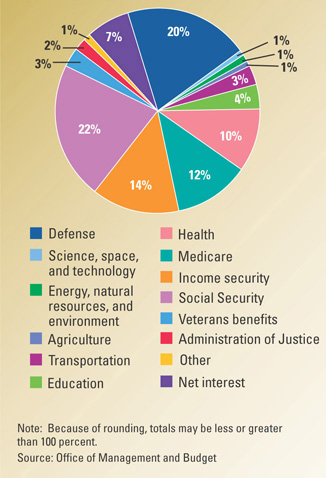Section 3 Federal Spending
Preview
Objectives
After studying this section you will be able to:
- Distinguish between mandatory and discretionary spending.
- Describe major entitlement programs.
- Identify categories of discretionary spending.
- Explain the impact of federal aid to state and local governments.
Section Focus
Although the federal budget is extremely large, about three quarters of the government's spending is required by current laws. Major categories of government spending include Social Security, defense, interest on the national debt, Medicare, and health care.
Key Terms
- mandatory spending
- discretionary spending
- entitlement
- Medicaid
Suppose that each year you were given almost $1.9 trillion to spend. So much money! So many choices! In reality, when the federal government receives this amount of revenue in the form of taxes, most of it is already accounted for. That is, after the government fulfills all its legal obligations, only about 26 percent of the money remains. In this section you will look at the many items on which the federal government spends its tax revenues. In Chapter 15, you will read about how the federal government, as part of the budget process, plans for that spending.
Mandatory and Discretionary Spending
The graph in Figure 14.6 shows the major categories of federal spending. Some of these categories, such as Social Security and Medicare, are “mandatory.” Mandatory spending refers to money that lawmakers are required by existing laws to spend on certain programs or to use for interest payments on the national debt. Others, such as defense and education, are “discretionary.” Discretionary spending is spending about which government planners can make choices.
mandatory spending spending on certain programs that is mandated, or required, by existing law
discretionary spending spending category about which government planners can make choices

Image Long Description
Figure 14.6 Federal Spending, 2004
Building Key Concepts
The federal government spends the funds it collects from taxes and other sources on a variety of programs.
Government Analyze the categories of expenditures in the federal budget. Which categories receive the most federal funds?
In general, the percentage of federal spending that is mandatory has grown in recent years. The percentage of discretionary spending has decreased. These trends worry many budget planners and politicians.
Table of Contents
- Section 1 Benefits of Free Enterprise
- Section 2 Promoting Growth and Stability
- Section 3 Providing Public Goods
- Section 4 Providing a Safety Net
- Real-life Case Study: Government and the Interstate Highway System
- Chapter 3 Assessment
- The Wall Street Journal. Classroom Edition Debating Current Issues: Health-Care Costs
- Section 1 Perfect Competition
- Section 2 Monopoly
- Section 3 Monopolistic Competition and Oligopoly
- Section 4 Regulation and Deregulation
- Real-life Case Study: Regulating Cable Television
- Chapter 7 Assessment
- The Wall Street Journal. Classroom Edition Debating Current Issues: Oil and Energy Dependence
- Section 1 Levels of Development
- Section 2 Issues in Development
- Section 3 Financing Development
- Section 4 Transitions to Free Enterprise
- Real-life Case Study: The World Bank and Economic Assistance
- Chapter 18 Assessment
- The Wall Street Journal. Classroom Edition Debating Current Issues: Tariffs and Trade




